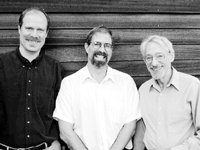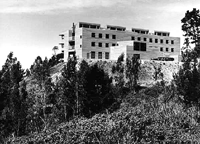Connections, Connections, Connections
December 7, 1999

Setting the author straight on the Mathematical Sciences Research Institute's place in the world was MSRI deputy director Joe Buhler (left). With him are MSRI director David Eisenbud (center) and special projects director Robert Osserman.
Philip J. Davis
Sitting on Grizzly Peak, high in the clouds above Berkeley, California, with its positive y-axis pointed directly toward the Golden Gate Bridge (a fact asserted with more assurance than is the presumptive orientation of Stonehenge), with its mortgage to UC Berkeley not yet paid off, the site of the Mathematical Sciences Research Institute (MSRI) seems to express well the remoteness of mathematical thought from all human connections. Here, it would seem, mathematicians can sit in their visually multiconnected minimall-like structure and, on eigendays when the fog permits, look out and see four major bridges.
An ideal altitude for lonesome thinkers to receive and record inspirational messages from Plato's God of Mathematics? "Not at all," MSRI deputy director Joe Buhler told me. (I paraphrase his comments.) "You have us all wrong. The mantra here is 'connections.' Connections to the various branches of mathematics; connections to the sciences, to technology; connections to the working life of the nation; connections to the politicians, to the community, to the men, the women, the kids in the schools, the media. Connections up, down, and sideways."
MSRI is now 18 years old. Irving Kaplansky (algebraist, formerly of the University of Chicago, and the second director of MSRI) tells the story (Mathematical Intelligencer, 1986) that sometime in the early 1960s, he was part of a distinguished committee assembled by Washington grantsmen to answer the question, What can we do for the mathematical world that would result in a quantum jump in the subject? Kaplansky, probably thinking about his short but pro-ductive stay at the Institute for Advanced Study in Princeton (founded in 1932), answered, "Fund two great centers." And presto prestissimo, after 20 or so years, centers were founded and funded (but not at Chicago, as Kaplansky had hoped).
"And has the quantum jump occurred?" I asked Kaplansky, who, though twice retired, once from the University of Chicago and once from MSRI, goes in to his office at MSRI and works matrices. Kaplansky smiled and answered, "Well. . . ."
A nasty question, I must admit. It seems I've learned to imitate the media professionals who regularly go for the politician's jugular.

The remoteness of the site of the Mathematical Sciences Research Institute belies MSRI's active agenda of reaching out to establish connections, not only with researchers in widely ranging areas of mathematics but throughout science and technology and, through activities like its Journalist in Residence program, with society.
What is the programmatic feel of the place? Very few permanent appointments. Ten week-long workshops scheduled between August 1999 and May 2000 (e.g., Constructive Galois Theory, Mathematics in Imaging, Quantum Groups). From 2000 to 2001, two half-year programs (in algorithmic number theory, spectral invariants) and one full-year program (in operator algebras). During my visit in July, to attend a meeting of the Association for Women in Mathematics (see SIAM News, November 1999), a summer program involving local young people was going on.
Once I got to know MSRI a bit, its programs, some of its people, its modes of communication, I agreed with Buhler: This was not solely an ivory tower of slowly digested and lonely thought. It struck me rather as a busy airport, like the SFO, with the MSRI administrators acting as flight controllers, frenetically dealing out special-interest chat flights from all conceivable directions of mathematical space.
Once upon a time, MSRI had a reputation for purity, a.k.a. "core research," while the Institute for Mathematics and Its Applications (IMA) at the University of Minnesota was the center responsible for applications. This appears to have changed somewhat. Response to NSF pressure? You'd better believe it. (Read "An Interview with D.J. Lewis," retiring director of the Division of Mathematical Sciences at NSF, in the Notices of the AMS, June/July 1999, pages 669-673.) Such pressure is to be expected. Bob and Jane and their representatives in Congress want to see some understandable returns for their tax dollars. Is there now any sensible reason for the separation of the pure and the applied, when each has been drawing more and more on the other?
Depending on how one counts, there are now in the U.S. at least five centers similar to MSRI. I include the granddaddy Institute for Advanced Study, which also receives some federal funding. According to Lewis, NSF would like to fund about seven such centers, each of finite duration, and each functioning along the same programmatic lines as MSRI.
One can argue into the wee hours of the morning whether an agenda whereby a topic of the week is announced, experts are assembled to bang the topic around and then rapidly flushed out to make room for the next group of experts (call this the Oberwohlfach model) makes for connections or intensifies separations. And one can argue---particularly in these days of budgetary surpluses and budgetary bean counting---whether centers are cost-effective, given the omnipresence of low-overhead workshops held at all manner of institutions, not to forget the hundreds of special-interest meetings.
The pressures on the temporary to become permanent are great, and though its NSF grant has been renewed for five more years, MSRI is working hard to get off the Washington bottle. (I note in passing that Oberwohlfach is now experiencing the same problem.)
Directors of centers do not have easy jobs. There is money to be raised, and if independence is sought, connections must be made to private institutions and individual philanthropists. A wide variety of programs must be planned---hot topics all---and there are warm bodies to be selected and ushered in and out. There are high-visibility projects from the public's point of view to be initiated and worked through. Directors seem to come, for reasons of scientific prestige, from university research environments, and the talents of research and of administration are not always found in the same person.
As a frequent writer, I was particularly interested in MSRI's establishment a little more than a year ago of the position of "Journalist in Residence." There have been four occupants, the one during my visit (for three months) being Ivars Peterson. Peterson is a writer/editor for Science News and the author of much popular and semi-technical writing. Some of his material can be viewed on the Web. Here is how Peterson described his personal mission:
"I have long argued that mathematicians ought to communicate their ideas and research effectively not only to the general public but also to their own mathematical colleagues and to scientists and engineers. I have attended far too many mathematics lectures where even mathematicians lose the talk's thread and begin to nod off, and I have glanced at too many research papers that fail to explain why a given topic is worth pursuing or to put the material in a broader context." Communication of mathematics to the public is admittedly difficult, for many reasons. Math has often been called the "Handmaiden of the Sciences," and it is precisely its handmaidenly status as the supplier of the infrastructure of science that removes its products from wider interest. The public wants to know about global warming or the Big Bang, the age of the universe, whether the latest hurricane will hit their beach cottage, how the genome project will affect their health. They don't want to hear about the mathematical equations, the theorems, the algorithms and computations that will lead to the conclusions.I was present recently at a dinner party where my follow guests were professors of biomedicine, law, and art. I told them that in a few days I would be appearing on the radio on a mathematical talk show series (run by Patricia Kenschaft of Montclair State College). They were incredulous. Really? A mathematical talk show? Who on earth would call in, and about what? If this is the response of professors, then a fortiori . . . How can there be public understanding without prior education?
We're living in an age of intense sensation and the cult of personality. I admire journalists who have the guts to take on mathematics, but I am irritated when, more often than not, they go for the sensational. I feel that such releases rarely capture what I think is important about the mathematical enterprise and its products. The only advice I can give to a mathematician confronted by a journalist is the same as to any person confronted by a journalist: learn how to suffer.
Communication from mathematician to mathematician has its own difficulties. One obvious reason is that there is just too much mathematics for one person to know with any breadth and depth. And all attempts to sum it up in a few books, from Pappus (300 AD) to Bourbaki, have failed.
Think only of the Springer Lecture Notes in Mathematics. There are more than 1500 volumes, on topics that once burned (or in some cases still burn) fiercely in the imaginations of their authors. How many of these topics are taught in graduate courses? How much of the contents of one set of notes is known to the author of an adjacent set?
Though far from a cure-all, a journalist in residence at MSRI is a move in the right direction. I would even argue for more of the same. Years ago, the presidents of the United States used to write their own speeches. This practice has been abandoned, and the White House has long had a stable of writers attached to it.
I suggest that each research department of mathematics have an experienced writer in residence who will describe for purposes of consumption both within and without the field what is going on in that department. I personally have found such writing informative and useful.
Why should we go for it? Well, don't mathematicians employ skilled Web masters to create their self-advertisements? Don't we have computer mavens resident in our departments to rescue us whenever our terminals squeak the wrong way? Don't academics make use of professional grant specialists to help them with their proposals? Do we write our basic math software ourselves, or do we allow specialized companies to provide this infrastructure for us (and to reap gold as a corollary)?
There is a paradox at work. Modes of communication have multiplied mightily. Connections between mathematics and other disciplines are being made productively and are increasing in frequency. Yet when I and many others go to large meetings, we go largely to network. We cannot understand most of the talks. And afterward, I'm left with a feeling that our lovely subject will soon end up as fractal dust.
Can mathematical journalism help?
Philip J. Davis, professor emeritus of applied mathematics at Brown University, is an independent writer, scholar, and lecturer. He lives in Providence, Rhode Island.

